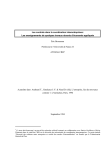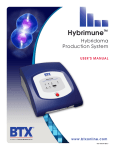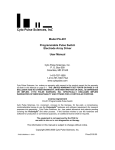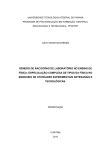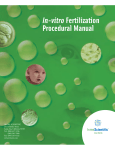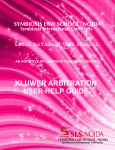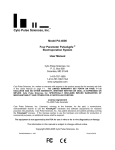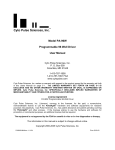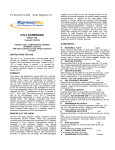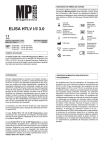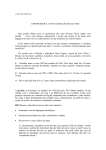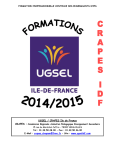Download Cyto Pulse Sciences, Inc.
Transcript
TM Cyto Pulse Sciences, Inc. Model PA-101 Electrofusion System User Manual Cyto Pulse Sciences, Inc. P. O. Box 609 Columbia, MD 21045 1-410-787-1890 1-410-787-1891 FAX www.cytopulse.com Cyto Pulse Sciences, Inc. makes no warranty with respect to the product except for the warranty set forth in this Users Manual on page 5-1. The LIMITED WARRANTY SET FORTH ON PAGE 5-1 IS EXCLUSIVE AND NO OTHER WARRANTY WHETHER WRITTEN OR ORAL, IS EXPRESSED OR IMPLIED. Cyto Pulse Sciences, Inc. SPECIFICALLY DISCLAIMS IMPLIED WARRANTIES OF MERCHANTABILITY AND FITNESS FOR A PARTICULAR PURPOSE. License Agreement PA-101 Electrofusion Cyto Pulse Sciences, Inc. (Licensor), conveys to the licensee, for fee paid, a nonexclusive, nontransferable license to use the PulseAgile® hardware and software (equipment) for research purposes into perpetuity. Cyto Pulse Sciences, Inc., has patent allowance and patents pending covering the PulseAgile® and other process. If the licensee wishes to use the hardware and software for production or commercial purposes, an additional license shall be required. The equipment is not approved by the FDA for use with in vitro or in vivo diagnostics or therapy. The information in this manual is subject to change without notice. Copyright 2000-2005 Cyto Pulse Sciences, Inc. PA101UMANrev.1-1/05 Price $100.00 PA-101 User Manual: Rev.1-1/05 TM Cyto Pulse Sciences, Inc. Model PA-101 Electrofusion System User Manual Cyto Pulse Sciences, Inc. P. O. Box 609 Columbia, MD 21045 1-410-787-1890 1-410-787-1891 FAX www.cytopulse.com Cyto Pulse Sciences, Inc. makes no warranty with respect to the product except for the warranty set forth in this Users Manual on page 5-1. The LIMITED WARRANTY SET FORTH ON PAGE 5-1 IS EXCLUSIVE AND NO OTHER WARRANTY WHETHER WRITTEN OR ORAL, IS EXPRESSED OR IMPLIED. Cyto Pulse Sciences, Inc. SPECIFICALLY DISCLAIMS IMPLIED WARRANTIES OF MERCHANTABILITY AND FITNESS FOR A PARTICULAR PURPOSE. License Agreement PA-101 Electrofusion Cyto Pulse Sciences, Inc. (Licensor), conveys to the licensee, for fee paid, a nonexclusive, nontransferable license to use the PulseAgile® hardware and software (equipment) for research purposes into perpetuity. Cyto Pulse Sciences, Inc., has patent allowance and patents pending covering the PulseAgile® and other process. If the licensee wishes to use the hardware and software for production or commercial purposes, an additional license shall be required. The equipment is not approved by the FDA for use with in vitro or in vivo diagnostics or therapy. The information in this manual is subject to change without notice. Copyright 2000-2005 Cyto Pulse Sciences, Inc. PA101UMANrev.1-1/05 Cyto Pulse Sciences, Inc. P. O. Box 609, Columbia, MD 21045 USA 410-787-1890 Price $100.00 i PA-101 User Manual: Rev.1-1/05 Blank page ii Cyto Pulse Sciences, Inc. P. O. Box 609, Columbia, MD 21045 USA 410-787-1890 PA-101 User Manual: Rev.1-1/05 Table of Contents page 1. Introduction 1-1 2. Electrofusion Background 2-1 2.1 2.2 2-1 2-1 2-1 2-2 2-3 2-3 2-3 2-6 2-6 2-7 2-7 2.3 2.4 2.5 3. 4. PA-101 Set-up and Operation 3-1 3.1 3.2 3.3 3.4 3.5 3.6 3-1 3-1 3-2 3-2 3-2 3-4 Introduction Connecting the PA-101 to the PA-4000 PA-101 Front panel functions Turning unit on Coaxial Electrode Software Getting Started 4-1 4.1 4.2 4.3 4-1 4-2 4-2 4-2 4-2 4-2 4-2 4-2 4-3 4-3 4-4 4.4 4.5 4.6 5. Introduction Preparation for electrofusion 2.2.1 Media 2.2.2 Cleaning and Sterilization of Electrode 2.2.3 Washes and other preparatory needs Three step electrofusion 2.3.1 Step 1 - Cell alignment 2.3.2 Step 2 – Fusion Pulse 2.3.3 Step 3 - Post fusion cell alignment maintenance Post fusion cell care Electrofusion references Published protocols Programming a protocol General electrofusion method, Materials 4.3.1 Electrofusion apparatus 4.3.2 Cell fusion medium 4.3.3 Complete cell growth medium 4.3.4 Electrode 4.3.5 Microscope General electrofusion method, cell preparation General electrofusion method, electrofusion Optimizing Customer Service 5-1 5.1 5.2 5-1 5-1 Limited Warranty Customer Service Cyto Pulse Sciences, Inc. P. O. Box 609, Columbia, MD 21045 USA 410-787-1890 iii PA-101 User Manual: Rev.1-1/05 List of Figures iv 2-1 2-2 2-3 Non-uniform Field Force Cell Alignment Clausius-Mossotti Function 2-4 2-4 2-5 3-1 3-2 3-3 3-4 Cell fusion system Back panel interconnections Components of electrofusion waveforms Electrofusion mode screen 3-1 3-1 3-4 3-5 4-1 Example of cell alignment with K562 cells 4-4 Cyto Pulse Sciences, Inc. P. O. Box 609, Columbia, MD 21045 USA 410-787-1890 PA-101 User Manual: Rev.1-1/05 Caution Notice This instrument contains a high voltage power supply adjustable beyond 1,000 volts: such voltage can be lethal. The user must read this manual carefully before the instrument is placed into operation. Removing the cover may void the warranty. Do not connect or disconnect the high voltage cable with the high voltage enabled. To connect or disconnect the cable, turn line power off and unplug line cord. Do not open the cuvette holder while the high voltage is on. If a problem occurs during a run, push the STOP/RESET button on the front panel. If there are any questions about the operation of this instrument, call Cyto Pulse Customer service. Cyto Pulse Sciences, Inc. P. O. Box 609, Columbia, MD 21045 USA 410-787-1890 v PA-101 User Manual: Rev.1-1/05 Blank Page vi Cyto Pulse Sciences, Inc. P. O. Box 609, Columbia, MD 21045 USA 410-787-1890 PA-101 User Manual: Rev.1-1/05 1 Introduction Electrofusion has many uses in the fields of cell biology, medicine and microbiology. The PA101 add-on to the PA-4000 computer controlled electroporator provides cell alignment capabilities in addition to the versatile capabilities of the PA-4000. All parameters are computer controlled to give the operator maximum flexibility in performing cell fusion protocols. This manual is designed to help you get the most benefit from using PulseAgile® electrofusion. It contains information on how to operate the electroporator, safety tips, and information useful for successfully performing your electrofusions. Note: The PA-4000 with the PA-101 contains a high voltage power supply and was designed with safety features to protect the user and the equipment. If used properly, the PA-4000 with the PA-101 is a safe and reliable instrument. Chapter 3 explains some important concepts related to operator safety, in addition to concepts needed for accurate use of the instrument. Chapter 3 must be read before setting up this instrument. Our goal is the safe and productive use of the PA-4000 with the PA-101 Cyto Pulse Sciences, Inc., P. O. Box 609, Columbia, MD 21045 USA 410-787-1890 1-1 PA-101 User Manual: Rev.1-1/05 Blank Page 1-2 Cyto Pulse Sciences, Inc., P. O. Box 609, Columbia, MD 21045 USA 410-787-1890 PA-101 User Manual: Rev.1-1/05 2 Electrofusion Tutorial 2.1 Introduction Electrofusion is a multi-step process consisting of the following phases: • Preparation of cells for electrofusion • Three-step electrofusion • Pre-fusion dielectrophoresis to align cells High voltage pulse to induce fusion Post-fusion dielectrophoresis to maintain alignment for maturity Care of cells after fusion Each of these phases is critical for a successful outcome. 2.2 Preparation for electrofusion 2.2.1 Medium The first consideration is the fusion medium. Media of high quality must be used or the electrofusion will fail. One example of a poor medium would be one containing excessive ions due to the addition of inorganic acids or bases in order to adjust the pH. The presence of the ions will increase conductivity enough to result in excessive heat that will kill the cells. Cyto Pulse Cell Fusion Medium is prepared using GLP manufacturing standards. It is tested for pH, endotoxin, conductivity, sterility and other quality control parameters. For consistent results, we suggest using this medium for your cell fusions. !The most common reason for electrofusion failure is the use of poor quality medium! Cells need to be in a high resistance medium for two reasons. One is that the cell alignment step, dielectrophoresis, is dependent upon there being a difference between the resistivity of the cell cytoplasm and the resistivity of the medium outside a cell. Second, the high current generated in a highly conductive media will cause excessive heating. The heating will, at first, cause convection currents and disrupt pearl chains. If the heating persists, the temperature of the medium will rise to critical levels and kill the cells. We use resistivity (conductivity) to describe the resistance of the medium because resistivity takes into account the volume of liquid in an electrode. Remember that, for a parallel plate electrode, resistivity (ρ) is related to resistance (ohms) by the formula: R=ρ∗ l ohms A2 where: ρ = Resistivity in ohm-cm σ = Conductivity in S/cm = 1/ρ Cyto Pulse Sciences, Inc., P. O. Box 609, Columbia, MD 21045 USA 410-787-1890 2-1 PA-101 User Manual: Rev.1-1/05 l = plate spacing A = plate area For a coaxial electrode the equation is: R=ρ − ln (a / b) ohms 2π h where: ρ = Resistivity in ohm-cm σ = Conductivity in S/cm = 1/ρ a = inner electrode diameter b = outer electrode diameter h = electrode height Common resistivity measurements are in the range of 7,000 to 17,000 Ω-cm for cell fusion medium. This is equivalent to a conductivity of 143 to 60 µS/cm. Conductivity is the reciprocal of resistivity. To obtain a medium with a high resistivity or low conductivity, a low ionic medium is used. The resistance of the three commercially available Cyto Pulse coaxial electrodes when filled with Cyto Pulse low conductivity media (CPS-LCM-C) to the indicated volume is: Cyto Pulse Electrode Units FE-25/400 FE-25/800 FE-20/1000 Volume µl 350 750 1000 Resistance ohms 2,874 1,341 617 Inner diameter mm 7.9 7.9 18.0 Outer diameter mm 13 13 22 Gap mm 2.5 2.5 2.0 Height mm 5.0 10.0 10.0 Another important property of the electrofusion medium is the osmolarity. The osmolarity of electrofusion media is usually isoosmolar (normal osmolarity of body fluids, 290 mOs). The use of hypo-osmolar media has been reported (10). Hypo-osmolar medium reportedly increases electrofusion efficiency. The efficiency increase occurs if cells are exposed to hypo-osmolar medium then returned to iso-osmolar medium. The lasting effect may be due to changes in the cell cytoskeleton due to cell swelling. The use of iso-osmolar medium in the final wash is recommended. Cyto Pulse Cytofusion medium is an optimized iso-osmolar electrofusion medium designed for optimal results. Cyto Pulse recommends that this medium be used for electrofusion. 2.2.2 Cleaning and sterilization of the electrode before use. The integrity of the electrofusion process depends upon low conductivity. Any contaminants remaining in the electrode from previous electrofusion runs will hinder the 2-2 Cyto Pulse Sciences, Inc., P. O. Box 609, Columbia, MD 21045 USA 410-787-1890 PA-101 User Manual: Rev.1-1/05 electrofusion. A thorough cleaning immediately after use is required. The following process should be used: 1. Cleaning a. b. c. d. e. Rinse the electrode well in reagent grade water. Fill the electrode with 4% sodium hydroxide and soak for 5 minutes. Rinse for 10 seconds in reagent grade water, empty and repeat 10 times. Rinse in 70% Ethanol or Isopropanol. Air dry. 2. Sterilization of electrode, one of two processes can be used: a. Soak in 70% ethanol for 10 minutes, or b. Autoclave for 20 minutes at 15 psi. This is a better method of sterilizing but it will limit the life of the electrode. 2.2.3 Washes and other preparatory needs It is important that all tissue culture medium be washed from the cells prior to electrofusion. This requires a minimum of one centrifugation plus two washes in electrofusion medium. Residual ions from an incomplete wash may ruin the electrofusion. For the cell washes, it may be useful to wash the two cell populations separately. This has two advantages. One is that if there is differential cell loss during the washes, compensation can be made during the mixing of the cells after the last wash. For instance, myeloma cells are larger than B cells and may centrifuge differently. Another advantage of combining the cells after the last wash is that the two cell populations may be stained with fluorescent dyes to differentiate the two cells after fusion and to identify fused cells. Stained cells must be washed in separate washes to prevent bleeding of the dye from one population to the other during the washes. If the cells used in the electrofusion are immortalized tissue culture cells, the process is most efficient when cells in log growth phase are used. Primary cells may not divide in tissue culture and therefore may not be obtained in log phase. It is also advisable to do the washes immediately prior to electrofusion. Electrofusion medium is non-toxic but cells will become fragile after excessive time (>1 hour) in the electrofusion buffer. Buffer quality control. The following should be evaluated: • PH (7.3 + 0.1) • Osmolarity (285-295 mOs) • Conductivity < 100 microsiemens/cm • Sterility • Endotoxin level 2.2.4 Mixing the Cells Prior to putting the cells into the electrofusion electrode, the two cell populations need to be mixed. The ratio of cells in one population to the other cell population should be Cyto Pulse Sciences, Inc., P. O. Box 609, Columbia, MD 21045 USA 410-787-1890 2-3 PA-101 User Manual: Rev.1-1/05 approximately one to one. However, uneven ratios may be needed if hetero-fusions are not as high as expected (i.e. ½ of the fusions). The concentration of cells during electrofusion needs to be consistent from time to time because the length of pearl chain is cell concentration dependent. Cell concentrations from 1 million to 10 million cells per ml are generally used. 2.3 Three step electrofusion 2.3.1 Step 1 - Cell alignment The first process in any cell fusion system is to bring the cells into contact. This can be done by one of many methods. Chemical methods such as Avidin-biotin bridging specifically selects, which two cells, are to come into contact. Chemical methods require more manipulation than other methods but can be useful in certain circumstances. Physical methods such as centrifugation can bring cells into contact prior to (or after) the fusion pulse. In any case, sufficient force must be applied to each cell to overcome the negative surface charge. 2.3.1.1 Non-Uniform Electric Field The Cyto Pulse PA-101 uses non-uniform electric fields. Merely applying a uniform electric field will not move a cell because the net charge of the cell is zero. Thus from the definition of electric field, there is no force applied: Force = Electric Field ∗ charge However, a non-uniform field moves the positive ions inside each cell to one side and the negative ions to the opposite side, producing a dipole. Once the dipole is induced, a net force is exerted on the cell because the intensity of the field is greater on one side than the other. The movement of cells in one direction causes the cells to concentrate in an area. Since the cells are now dipoles, the negative side of one cell will attract the positive side of another - + + - Figure 2-1: Non Uniform Field Force +- +- + - + - Figure 2-2: Cell Alignment cell overcoming the negative surface charge. This “pearl chain” process is illustrated below: The equation that predicts the forces applied by this very complex process is: FDEF = 2πε 1 K r 3 ∇E 2 This equation says three very important things: 2-4 Cyto Pulse Sciences, Inc., P. O. Box 609, Columbia, MD 21045 USA 410-787-1890 PA-101 User Manual: Rev.1-1/05 1. K is called the Clausius-Mossotti equation and has a maximum value of +1 and a minimum value of –1/2. The value is determined by the frequency of the voltage waveform, the dielectric constant and conductivity of the cell cytoplasm, the dielectric constant and conductivity of the medium. Since this parameter can be positive or negative, it determines the direction of the force on the cell and thus the direction it will move. If the properties of the medium are the same as the cytoplasm, then K=0 and no force is applied. Thus the properties of the medium are very important. See Figure 2-3. 2. The r in r3 is the radius of the cell. Thus the force on the cell increases as the cube of the radius. Large cells have much more force applied than smaller cells. There is also a countervailing force, the drag on the cell by the medium. The larger the cell the larger the drag. 3. ∇E2 describes the non-uniformity of the electric field in volts2/mm3. If the electric field is constant like in a cuvette with parallel plates, then this term is zero and no force is applied to the cells. The geometry of the electrode defines this value. Also note that since the electric field term is squared, the polarity of the electrodes makes no difference. The direction of movement is dependent on the electrode geometry. Clausius-Mossotti Function cell radius 7 um 1.000 0.800 0.600 0.400 PA-101 Frequency Range 0.200 K 0.000 -0.200 -0.400 -0.600 10 uS/cm -0.800 100 uS/cm -1.000 0.001 0.01 0.1 1 10 100 1000 Frequency Mhz Figure 2-3 Clausius-Mossotti Function Cyto Pulse Sciences, Inc., P. O. Box 609, Columbia, MD 21045 USA 410-787-1890 2-5 PA-101 User Manual: Rev.1-1/05 The Cyto Pulse cell fusion coaxial electrode has been optimized to convert the PA-101 sine wave voltage to an efficient non-uniform alternating field for cell alignment. It also converts the PA-4000 high voltage pulse(s) to a DC pulse electric field for cell fusion. The alignment process using dielectrophoresis is a function of: • The time that the AC wave is on • The intensity of the AC electric field • The frequency of the AC electric field • The non-uniformity of the AC electric field The first three parameters are selected using the PA-4000 interface software, and the last parameter is a property of the coaxial electrode The following chart shows the approximate intensity of the AC field for the three Cyto Pulse electrodes at a set ac voltage of 75 volts-peak. The field is non-uniform the values below are given at the inner electrode, mid way, and at the outer electrode. Part No. FE-25/400 FE-25/800 FE-20/1000 Gap mm 2.5 2.5 2.0 Inner V/cm 179 179 415 Mid V/cm 135 135 373 Outer V/cm 109 109 340 2.3.2 Step 2 – Fusion Pulse The second step in electrofusion is to apply one or more high voltage pulses to the cells, inducing membrane fusion. The voltage required must be above a threshold to induce membrane breakdown and below a maximum voltage causing cell death. Threshold voltage is approximately 0.5-1.5 volts across the cell membrane (1). The voltage across a cell is approximately equal to: Vt = 1.5 ∗ r ∗ E cos θ volts where: r = cell radius in cm E = electric field intensity in v/cm Θ = angle of the membrane in relation to the direction of the field Electric fields 2-3 times threshold can be used. This should be optimized for the cells used. Multiple fusion pulses may be more efficient than a single pulse. The table below gives the approximate electric field intensity for a pulse of 800 volt in the Cyto Pulse electrodes. Part No. FE-25/400 FE-25/800 FE-20/1000 2-6 Gap mm 2.5 2.5 2.0 Inner V/cm 4087 4087 4430 Mid V/cm 3107 3107 3990 Outer V/cm 2496 2496 3624 Cyto Pulse Sciences, Inc., P. O. Box 609, Columbia, MD 21045 USA 410-787-1890 PA-101 User Manual: Rev.1-1/05 2.3.3 Step 3 - Post fusion cell alignment maintenance The last step in the electrofusion process is post fusion alignment maintenance. Electrofusion is a process that continues to occur over some time after the fusion pulse is applied. Re-applying dielectrophoresis at a lower AC voltage (the cell are already aligned) after the fusion pulse allows maturation of the fusion process by holding cells in optimal alignment and contact. 2.4 Post fusion cell care Cell fusion continues to occur over 10 to 30 minutes after electrofusion. The cells are very fragile at this point and should not be disturbed. Cells should sit in the cell fusion electrode for 30 minutes. At the end of the 30-minute time, the cells can be washed by centrifugation. Centrifugation is the most common method for exchanging cell fusion medium for tissue culture medium. An alternate, gentler, method would be to use a filter to exchange the medium. Cells do not do well in cell fusion medium over extended periods of time. Incubation beyond the 30 minutes required for fusion maturation is not recommended. For hybridoma selection, standard protocols using selective medium are used. Exposure to selective medium may be delayed for one day to allow cells time to stabilize. 2.5 Electrofusion References 1. Neil GA, Zimmermann U. Electrofusion. Methods Enzymol 1993;220:174-96. 2. Vienken J, Zimmermann U. An improved electrofusion technique for production of mouse hybridoma cells. FEBS Lett 1985;182:278-80. 3. Ohno-Shosaku T, Okada Y. Electric Pulse induced fusion of mouse lymphoma cells: Roles of divalent cations and membrane lipid domains. J Membrane Biol 985;85;269-80. 4. Elsheikh AS, Takahashi Y, Tanaka H, Hishinuma M, Kanagawa H. Electrofusion of zona-free mouse embryonic cells in electrolytes and their development in vitro. Jpn J Vet Res 1995;43:125-34. 5. McClenaghan NH, Barnett CR, O'Harte FP, Swanston-Flatt SK, Ah-Sing E, Flatt PR. Characteristics of BRIN-BG5 and BRIN-BG7, two novel glucose-responsive insulin-secreting cell lines produced by electrofusion. J Endocrinol 1996;148:409-17. 6. Ogura A, Matsuda J, Yanagimachi R. Birth of normal young after electrofusion of mouse oocytes with round spermatids. Proc Natl Acad Sci U S A 1994;91:7460-2. 7. Willadsen SM. Nuclear transplantation in sheep embryos. Nature 1986;320:63-5. 8. Vienken J, Zimmermann U, Fouchard M, Zagury D. Electrofusion of myeloma cells on the single cell level. Fusion under sterile conditions without proteolytic enzyme treatment. FEBS Lett 1983;163:54-6. 9. Wojchowski DM, Sytkowski AJ. Hybridoma production by simplified avidin-mediated electrofusion. J Immunol Methods 1986;90:173-7. Cyto Pulse Sciences, Inc., P. O. Box 609, Columbia, MD 21045 USA 410-787-1890 2-7 PA-101 User Manual: Rev.1-1/05 10. Zimmermann U, Gessner P, Schnettler R, Perkins S, Foung SK. Efficient hybridization of mouse-human cell lines by means of hypo-osmolar electrofusion. J Immunol Methods 1990;134:43-50. 11. Foung S, Perkins S, Kafadar K, Gessner P, Zimmermann U. Development of microfusion techniques to generate human hybridomas. J Immunol Methods 1990;134:35-42. 12. Eigel L, Oelmuller R, Koop HU. Transfer of defined numbers of chloroplasts into albino protoplasts using an improved subprotoplast/protoplast microfusion procedure: transfer of only two chloroplasts leads to variegated progeny. Mol Gen Genet 1991;227:446-51. 13. Steenbakkers PG, van Meel FC, Olijve W. A new approach to the generation of human or murine antibody producing hybridomas. J Immunol Methods 1992;152:69-77. 14. Grobner, U., Berg, H., Polylysine supports electrofusion, Bioelectrochemistry and Bioenergetics, 1992, 39:181-184 15. Jaroszeski, Mark J; Gilbert, Richard; Heller; Detection and Quantitation of Cell-Cell Electrofusion Products by Flow Cytometry, (1994) Analytical Biochemistry 216: 271-275 16. Hui, SW, Stenger, DA. Electrofusion of cells: Hybridoma production by electrofusion and polyethylene glycol, 1993, Methods in Enzymology, 220: 212-227 17. Kugler, A et. al. Regression of human metastatic renal cell carcinoma after vaccination with tumor cell-dendritic cell hybrids,2000, Nature Medicine 6(3):332-336 18. Schmitt, JJ, Zimmerman, U. Enhanced hybridoma production by electrofusion in strongly hypo-osmolar solutions, 1989, Biochem et Biophysica Acta, 983:42-50 19. Neil, GA, Zimmerman, U. Electrofusion, 1993, Methods in Enzymology, 220:174-196 20. Collas, P, Fissore, R, Robl, JM. Preparation of nuclear transplant embryos by Electroporation. 1993, Analytical Biochemistry, 208:1-9 21. Tatham, BG, Gilliam, KJ, Trounson, AO. Electrofusion parameters for nuclear transfer predicted using isofusion contours produced with embryonic cells. 1996, Molecular Reproduction and Development, 43:306-312 2-8 Cyto Pulse Sciences, Inc., P. O. Box 609, Columbia, MD 21045 USA 410-787-1890 PA-101 User Manual: Rev.1-1/05 3 PA-101 Set-Up and Operation 3.1 Introduction The PA-101 is an attachment to the PA4000S PulseAgile® electroporator. It provides the capability of applying a low voltage, megahertz frequency sine wave to the cell suspension prior to and after application of a high voltage pulse. The applied sine wave serves the purpose of aligning cells in a line called a pearl chain. The process is called dielectrophoresis and is useful for placing cells into proper contact for electrofusion. The dielectrophoresis unit is designed to work with a high resistance load. Do not use highly ionic buffers in the devices for this unit. If ionic buffers are used, two things will happen. First, the sine wave will not effectively induce pearl chain formation. Second and most important, a high amount of heat will be generated, killing all of the cells. Figure 3-1: Cell Fusion System PA-4000/PA-101 3.2 Connecting the PA-101 to the PA-4000 Follow the instructions in Chapter 4 of the PA-4000 manual to set-up the PA-4000. The PA-101 should be in place on top of the PA-4000. There are five connections on the back of the PA-101. The Line/Mains Switch must be off and the cord unplugged from the PA-4000. • Attach the option interconnect cable to the DB25 jacks on the back of the PA-101 and the PA-4000. The option interface cable is a 25-wire ribbon with a DB25 plug on each end. • Plug the Line/Mains cord from the PA-101 into the Hardware Option Power outlet on the back of the PA-4000. • Connect the high voltage cable. This cord delivers the high voltage pulse generated by the PA4000 to the PA-101. It is a coaxial cable with MHV connectors on each end. DO NOT ATTEMPT TO USE A CABLE WITH BNC CONNECTORS!!! • Connect the high voltage cable from the FE10 Fusion Plate Holder to the AC + Pulse OUT SHV jack on the back of the PA-101. • Connect the cable with the RCA-type phono plug from the FE-10 to the Cuvette Interlock connector on the back of the PA-4000. Figure 3-2: Back Panel Interconnections Cyto Pulse Sciences, Inc. P. O. Box 609, Columbia, MD 21045 Voice: 410-787-1890 3-1 PA-101 User Manual: Rev.1-1/05 3.3 PA-101 Front Panel Functions There are four indicators on the front panel. • Power On Green LED (light emitting diode) – This indicates that the Main/Power cord is connected properly and should be on if the Main/Line Power is on. • Interface Green LED – This indicates if the DB25 Interface Cable is connected properly and should be on if the Main/Line Power is on. • AC ON Red LED – This is illuminated when the AC sine wave is on. • Load – This indicator is a series of 10 separate LEDs. It indicates the relative resistance of the load and therefore the amount of heat that is being generated in the coaxial electrode. In normal operation, segments up to five may be illuminated depending on the volume of buffer cells in the electrode. If five segments are lit, this is approximately a 400 Ω load with a 75-volt peak applied voltage at 1 MHz frequency. If there are more than five segments illuminated, significant heat is being generated indicating too many ions in the solution. 3.4 Turning the unit on After the set-up described in Chapter 4 of the PA-4000 manual and section 3.2 of this manual is complete, the unit is ready to be used. The following sequence of events needs to be completed. • Plug the Line/Mains cord into the PA-4000. • Turn on the Main/Line Switch on the front of the PA-4000 • Check the Power On and HV Off green LEDs are illuminated on the front of the PA-4000. • Check the Power On Green LED and Interface Green LED are illuminated on the PA-101. 3.5 Coaxial Electrode The Pulse high voltage parameter settings are similar to the PA-4000 Electroporation mode. There is only one voltage range 5 to 800 volts. The intensity of the AC filed and pulse field is shown in Section 2. 3.6 Software Details of software installation and operation of the PA-4000 are described in Chapter 4 of the PA-4000 manual. The software that operates the PA-101 is included in the PA-4000 software file. When the PA-101 Interface cable is connected the software is activated. • Open the PulseAgile® application software. • In the Options Connected area at the upper right, the PA-101 block is now checked. This indicates the interface between the PA-4000 and the PA-101 is working properly. • Either set-up or open an electrofusion protocol. If the user has developed protocols previously just open the protocol folder and click on the desired protocol. If this is the first time then a new protocol must be “programmed”. Click “Electrofusion” on the upper left of the screen. Then click ADD at the right of the screen and enter the parameters values, and save the protocol. 3-2 Cyto Pulse Sciences, Inc. P. O. Box 609, Columbia, MD 21045 410-787-1890 PA-101 User Manual: Rev.1-1/05 In the Electrofusion Mode, both pre-pulse and post-pulse sinusoidal AC may be added. Figure 3-3 shows the components of electrofusion waveforms. Pulse Amplitude Pulse Width Frequency Stop AC amplitude Start AC amplitude AC Duration Pre-Pulse AC Wave Post-Pulse AC Wave Figure 3-3: PA-101 Waveforms Settings available for the PA-101 are as follows: Start Stop Frequency Duration 5-75 volts peak, step size 5 volts 5-75 volts peak, step size 5 volt 0.20 to 2 MHz, step size 0.2 MHz 1 to 400 seconds If zero in entered in the duration, no sine wave occurs. Form example, if zero is entered in the post sine duration, there is no post sine wave delivered. It is important to understand the various terms for the amplitude of the AC waveform. Volts peak – the amplitude from zero to the peak Volts peak-to-peak – The amplitude from the bottom peak to the top peak. The PA-101 produces a maximum amplitude of 75 volts peak or 150 volts peak to peak. The screen for the Electrofusion mode is presented in Figure 3-4. Cyto Pulse Sciences, Inc. P. O. Box 609, Columbia, MD 21045 Voice: 410-787-1890 3-3 PA-101 User Manual: Rev.1-1/05 Figure 3-4: Set-up Screen PA-101 3-4 Cyto Pulse Sciences, Inc. P. O. Box 609, Columbia, MD 21045 410-787-1890 PA-101 User Manual: Rev.1-1/05 4 Getting started, Sample Protocol 4.1 Published Protocols If possible, start with a published protocol and optimize parameters to suit your needs. For many of the standard uses for electrofusion, there are several published protocols. The following list is a sample of published values: Sine wave pre-fusion Fusion Sine wave post-fusion Cells Reference 50 V/cm 700 V/cm none mouse embryo 5-15 sec 2 pulses mouse oocytes (6) 70 uS 20-50 V/cm* 1.5 kV/cm* 100 V/cm 2 MHz* 3.7-4 kV/cm 2 MHz 10 sec* 10 uS 15-30 sec 300 V/cm 750 V/cm Sheep embryo (7) 600 Khz 3 pulses 300 V/cm tapering to 0 over 1 min 5-10 sec 100 uS 200 V/cm 2.5 kV/cm NA (8) 800 kHz 20 uS SP2/O, X63 single cells 250 V/cm 2.25 kV/cm 250 V/cm (10) 1.5 MHz 3 pulses 1.5 MHz mouse myeloma, 250-300 V/cm 1.5-5 kV/cm 30 sec human/mouse heteromyeloma NA human B cells, 3 pulses 28-35 V/cm 1.4-2 kV/cm 1 MHz multiple pulses (11) K6H6/B5 myeloma NA plant protoplasts (12) *Activation step only Note that all voltage values are given in volts/cm. This is the convention. To convert the volts/cm to applied voltage multiply the volts/cm by the gap. For example, with the coaxial electrode, the gap is 2.5 mm, so the V/cm will be multiplied by 0.25 cm to obtain the applied voltage. For 200 V/cm, the applied voltage would be 50 volts. Cyto Pulse Sciences, Inc. P. O. Box 609, Columbia, MD 21045 Voice: 410-787-1890 4-1 PA-101 User Manual: Rev.1-1/05 4.2 Programming a protocol Similar to the electroporation protocols, the concept of pulse groups is important. Pulse groups are modified by selecting the group, modifying the parameters as desired then clicking REPLACE. Note that changes will not be accepted into the protocol until the REPLACE button has been selected. Only one pulse group is used with electrofusion. For electrofusion, a pulse group is one pre-sine setting, one high voltage pulse and one post sine setting. For electrofusion, only one pulse group can be selected. The number of pulses in the “pulses” selection window means a repeat of the high voltage pulses only. For example, to program the following protocol would require the settings in the table below: • a 1.2 MHZ pre-sine wave with a ramp of 5 to 60 volts over 20 seconds • 5 pulses of 300 volts and 100 µs duration and 0.125 second interval • and a 1.2 MHZ post sine wave with a ramp of 20 to 5 volts over 30 seconds Group, number of pulses Parameter Group 1 Number = 5 Volts Beginning Duration Frequency MHz Volts Ending 4.3 4.3.1 Pre-sine High Voltage Pulse 5 20.0 s 1.2 60 300 0.100 ms Post-sine Interval 20 30.0 s 1.2 5 0.125 s General Electrofusion Method (Coaxial Electrode), Materials Electrofusion apparatus Cyto Pulse Sciences, Inc. PA-4000 with PA-101 dielectrophoresis accessory. 4.3.2 Cell fusion medium Use Cyto Pulse Low-Conductivity cell fusion medium for best results. Poor quality medium is the most common reason for electrofusion failure. Cell fusion medium formulas are described in Chapter 2. 4.3.3 Complete cell growth medium T he growth medium used will be cell type dependent. One cell growth medium is as follows: • Dulbeco’s Modified Essential Medium, 500 ml • Heat inactivated fetal bovine serum, 75 ml • L-glutamine (100X), 5 ml • Antibiotic mixture (100X), 5 ml 4.3.4 Electrode Coaxial electrode, 2.5 mm gap, 100 - 400 µl capacity. 4.3.5 Microscope An inverted microscope with long focal length objectives is needed. 4-2 Cyto Pulse Sciences, Inc. P. O. Box 609, Columbia, MD 21045 Voice: 410-787-1890 PA-101 User Manual: Rev.1-1/05 4.4 General Electrofusion Method (Coaxial Electrode), Cell Preparation • If desired, stain cells using fluorescent labels according to the cell labeling protocol • Count the cells in each population. Prepare an iso-osmolar, low conductance fusion medium or use Cyto Pulse commercial medium • Wash the cells 3 times in the new medium. A thorough wash is necessary Centrifuge cells at 400 X g for 10 minutes Pour off the supernatant Re-suspend the pellet with a gentle flick and adding 10 ml iso-osmolar or hypoosmolar fusion medium* Centrifuge cells at 400 X g for 10 minutes Pour off the supernatant Re-suspend the pellet with a gentle flick and adding 10 ml iso-osmolar fusion medium Centrifuge cells at 400 X g for 10 minutes • Re-suspend the cells at 1 to 10 million cells/ml in iso-osmolar fusion medium after the last centrifugation. Recount the cells after the last centrifugation to make sure that cells were not lost in the washes • Mix cell populations together in a pre-determined ratio (1:1 to 1:5) *On the second centrifugation of the wash, a hypo-osmolar medium may be used to increase cell fusion. The hypo-osmolar medium is made by diluting the iso-osmolar medium with three parts sterile distilled water and one part iso-osmolar medium. The cells should sit at room temperature for 5 minutes in the hypo-osmolar medium before the centrifugation. 4.5 General Electrofusion Method (Coaxial Electrode), Electrofusion, K562 cell example • Add 400 µl cell suspension to the coaxial fusion electrode. • Program the PA-4000 for a pre-fusion sine wave dielectrophoresis AC of 35 volts (beginning and ending voltage) at a frequency of 1.2 MHz for 30 seconds. • Program the PA-4000 for 2 fusion pulses at 500 volts (2 KV/cm) and 50 µs duration. • Program the PA-101 for a post-fusion sine wave dielectrophoresis AC of 25 volts beginning to 5 volts ending (ramp down) at a frequency of 1.2 MHz for 60 seconds. • Place the electrode in the holder ( see use of electrofusion holder). • Turn the high voltage on and start the process. • After the electrofusion is finished, remove the coaxial electrode and place it in a covered, moist dish at 37o C for 30 minutes to allow fusion maturation. • Move cells from the fusion electrode to a 15 ml conical tube. • Rinse remaining cells from the fusion electrode to the 15 ml conical tube • Wash the cells twice in 10 ml complete growth medium. Add 8-10 ml complete medium to the conical tube Centrifuge cells at 400 X g for 10 minutes Pour off the supernatant Re-suspend the pellet with a gentle flick and add 10 ml complete medium. Centrifuge cells at 400 X g for 10 minutes Pour off the supernatant Re-suspend the pellet with a gentle flick • Re-suspend the cells in the required amount of complete growth medium and incubate at 37o C. Cyto Pulse Sciences, Inc. P. O. Box 609, Columbia, MD 21045 Voice: 410-787-1890 4-3 PA-101 User Manual: Rev.1-1/05 Note: This is one example. The parameters listed in this protocol will need to be optimized for your cells. Figure 4-1 Example of cell alignment with K562 cells 4.6 Optimizing Dielectrophoresis is an observable event using a microscope with Cyto Pulse coaxial electrodes. Pearl chain length can be increased by: • increasing the voltage of the pre-fusion sine wave • increasing the time of pre-fusion sine wave application • Increasing the concentration of cells. Increased “pearl chain” length may not always be of advantage. Cell fusions of two cells only are the usual goal so a short pearl chain may be optimal. Pearl chains of a range of lengths will be present in any given dielectrophoresis application. Cell fusion between any two cells is a matter of probability related to the specific nature of the cells involved, the electrofusion medium, and the applied electric fields. Because of this, two cell electrofusions are possible in longer pearl chains. The goal of electrofusion, at least as applied to hybridoma formation, is to generate the most B-cell-myeloma hybridomas. Fusions of like cells (either B cells or myeloma) are not productive. This is a matter of probability with approximately 50 percent of the two cell fusions being B-cell-myeloma hybridomas. Other ratios are possible due to the difference in size of the B cells and myeloma cells. Optimization of fusion pulse voltage, width and number is achieved empirically. Systematically varying one parameter at a time while measuring hybridoma yield is necessary to optimize fusion pulse parameters. A faster experimental design is to use factorial analysis for the optimization. This method allows measurement of interactions among variables and is more efficient than varying one parameter at a time. 4-4 Cyto Pulse Sciences, Inc. P. O. Box 609, Columbia, MD 21045 Voice: 410-787-1890 PA-101 User Manual: Rev.1-1/05 5. Customer Service 5.1 Limited Warranty CYTO PULSE products are warranted against defect in materials and workmanship. If the customer provides notice of such a defect during warranty period, CYTO PULSE, at its option, will either repair or replace the products, which were found to be defective. The limited warranty set forth above is exclusive and no other warranty whether written or oral, is expressed or implied. CYTO PULSE specifically disclaims implied warranties of merchantability and fitness for a particular purpose. EXCEPT AS SET FORTH ABOVE, CYTO PULSE MAKES NO WARRANTY WITH RESPECT TO THE PRODUCT, AND IN NO EVENT, REGARDLESS OF CAUSE, SHALL CYTO PULSE BE LIABLE FOR INDIRECT, SPECIAL, OR CONSEQUENTIAL DAMAGES OR OTHER LOSSES OF ANY KIND ARISING FROM BREACH OR WARRANTY OR OTHER USES OF THIS PRODUCT. CYTO PULSE’S OBLIGATION TO REPAIR OR TO REPLACE TO THE EXTENT SET FORTH ABOVE CONSTITUTES THE EXCLUSIVE REMEDIES OF THE CUSTOMER FOR ANY BREACH OF WARRANTY. This warranty shall not apply to products, which after inspection by CYTO PULSE, were found to be improperly used or to have been modified in any manner. CYTO PULSE recommends that the user not open the product cabinet. This limited warranty is valid for one year from the date of shipment. 5.2 Customer Service If the user believes that there is a defect in the CYTO PULSE product, the customer should contact CYTO PULSE Customer Service through our website at www.cytopulse.com or phone 410-787-1890, or contact the local CYTO PULSE representative. A determination if the product is still in warranty will be made. If the warranty period is still in effect, the user will be given an authorization number (RMA) to return the product. If after receipt and inspection the product is found to be defective, it will be replaced or repaired and returned to the customer. If the product is found to have been modified or misused, the user will be given a quote for repair. If the warranty period has expired and the user requests repair, CYTO PULSE will inspect the product and provide a written quote for repair. The user must provide a purchase order number before the product will be repaired. If the unit is damaged in shipment, the user must recover the insured value to replace or repair from the carrier. Cyto Pulse Sciences, Inc. P. O. Box 609, Columbia, MD 21045 USA 410-787-1890 5-1 PA-101 User Manual: Rev.1-1/05 Blank page 5-2 Cyto Pulse Sciences, Inc. P. O. Box 609, Columbia, MD 21045 USA 410-787-1890




























